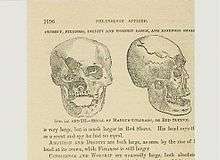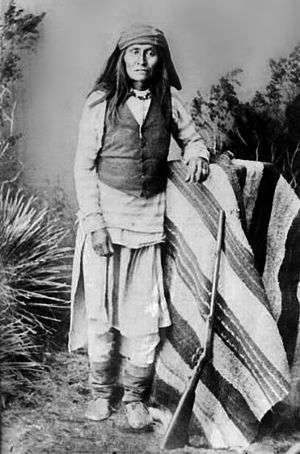Mangas Coloradas
| Mangas Coloradas | |
|---|---|
 Drawing of Skull of Mangas Colorados from 1873 book "Human Science" p. 1196 by Orson Squire Fowler | |
| Mimbreño Apache leader | |
| Succeeded by | Delgadito (killed 1864), Victorio |
| Personal details | |
| Born | c. 1793 |
| Died | January 18, 1863 (aged 69–70) |
| Military service | |
| Battles/wars | |
Mangas Coloradas (La-choy Ko-kun-noste, alias "Red Sleeve"), or Dasoda-hae ("He Just Sits There") (c. 1793 – January 18, 1863) was an Apache tribal chief and a member of the Mimbreño (Tchihende) division of the Central Apaches, whose homeland stretched west from the Rio Grande to include most of what is present-day southwestern New Mexico. He was the father-in-law of the Chiricahua (Tsokanende) Chief Cochise, the Mimbreño Chief Victorio and the Mescalero (Sehende) Chief Kutbhalla (probably to be identified with Caballero), and is regarded by many historians to be one of the most important Native American leaders of the 19th century due to his fighting achievements against the Mexicans and Americans.
The name Mangas Coloradas is the reception of his Apache nickname Kan-da-zis Tlishishen ("Red Shirt" or "Pink Shirt") by the Mexicans and is Spanish for Red Sleeves. A Bedonkohe (Bi-dan-ku – 'In Front of the End People', Bi-da-a-naka-enda – 'Standing in front of the enemy') by birth he married into the Copper Mines local group of the Chihenne and became the principal chief of the whole Chihenne Apache division, including the neighboring Mimbreño local group of the Warm Springs Chihenne, directly led by the famous chief Cuchillo Negro (in Apache language Baishan), second chief of the whole Chihenne Apache division.

Apache war leader
During the decades of the 1820s and 1830s, the Apaches' main enemy were the Mexicans, who had won their independence from Spain in 1821. By 1835, Mexico had placed a bounty on Apache scalps. After Juan José Compa, the leader of the Coppermine Mimbreño Apaches, was killed for bounty money in 1837 in the massacre at Santa Rita del Cobre, Mangas became a war leader and a chief, and began a series of retaliatory raids against the Mexicans, killing and destroying all around the mining town and placing Santa Rita under siege, finally attacking the column of fleeing Mexicans and slaughtering a large number.
Mangas Coloradas became the principal leader of the Coppermine Mimbreños, and led them for about 25 years, while his friend and long-time companion Cuchillo Negro led the Warm Springs Mimbreños.
In 1846, when the United States went to war with Mexico, the Apache Nation promised U.S. soldiers safe passage through Apache lands. Once the U.S. occupied New Mexico in 1846, Mangas Coloradas signed a peace treaty, respecting them as conquerors of the hated Mexican enemy. An uneasy peace between the Apache and the United States lasted until an influx of gold miners into New Mexico's Pinos Altos Mountains led to open conflict.
According to John C. Cremony's book, Life Among the Apaches, in 1851, near Pinos Altos mining camp, Mangas was attacked by a group of White miners who tied him to a tree and severely flogged him. Yet historian Edwin R. Sweeney finds issue with this claim in his biography of the chief: if it was true, Geronimo, who spent a great deal of time with Mangas during the 1850s and 1860s, would have mentioned that to his biographer as a reason for the war, yet he did not.
In December 1860, 30 miners launched a surprise attack on an encampment of Bedonkohes on the west bank of the Mimbres River. Historian Edwin R. Sweeney reported, the miners "... killed four Indians, wounded others, and captured thirteen women and children." Shortly after that, Mangas began raids against U.S. citizens and their property.
Mangas Coloradas' daughter Dos-Teh-Seh married Cochise, principal chief of the Chokonen Apache. In early February 1861, US Army Lieutenant George N. Bascom, investigating the "Indian" kidnapping of a rancher's son, apparently without orders, lured an innocent Cochise, his family and several warriors into a trap at Apache Pass, southeastern Arizona. Cochise managed to escape, but his family and warriors remained in custody. Negotiations were unsuccessful and fighting erupted.
This incident, known as the "Bascom Affair", ended with Cochise’s brother and five other warriors being hanged by Bascom. Later that year, Mangas and Cochise struck an alliance, agreeing to drive all Americans out of Apache territory. They were joined in their effort by Victorio, Juh and Geronimo. Although the goal was never achieved, the White population in Apache territory was greatly reduced for a few years during the Civil War, after federal troops had been withdrawn to the east.
Death
In the summer of 1862, after recovering from a bullet wound in the chest, Mangas Coloradas met with an intermediary to call for peace. In January 1863, he decided to meet with U.S. military leaders at Fort McLane, in southwestern New Mexico. Mangas arrived under a flag of truce to meet with Brigadier General Joseph Rodman West, an officer of the California militia and a future Reconstruction senator from Louisiana. Armed soldiers took Mangas into custody. West gave an execution order to the sentries.
| “ | Men, that old murderer has got away from every soldier command and has left a trail of blood for 500 miles on the old stage line. I want him dead tomorrow morning. Do you understand? I want him dead. | ” |
That night, Mangas was tortured, shot and killed "escaping". While tied on the ground, Mangas was provoked with red hot bayonets until he moved to simulate his attempt to escape.[2]
The following day, U.S. soldiers, fascinated by the size of the Apache (Mangas was 6 feet, 6 inches tall), cut off his head, boiled it and sent the skull to Orson Squire Fowler, a phrenologist in New York City. Phrenological analysis of the skull and two sketches of it appear in Fowler's book.[3] Daklugie, one of informants in Eve Ball's book,[4] said the skull went to the Smithsonian Institution.
However, the Smithsonian has done a thorough search for the skull, and reports that it never received it. Mangas' descendants and sources based on their testimony may have confused the Smithsonian with Fowler's Phrenological Cabinet in New York, where the skull was on display, leading to the misattribution. Another possible fate of the skull was that it was returned to the Apaches by the Smithsonian in a 1990 transfer, but was not individually labeled.[5]
The murder and mutilation of Mangas' body only increased the hostility between Apaches and the United States, resulting in war continuing for nearly another 25 years.
Appearances in literature
- Life Among the Apaches (1868) by John C. Cremony
- The Bandits from Rio Frio (1889) by Manuel Payno
- Apache (1931) by Will Levington Comfort
- Bury My Heart at Wounded Knee (1970) by Dee Brown
- Flashman and the Redskins (1982) by George MacDonald Fraser
- Blood Meridian (1985) by Cormac McCarthy
- Firestar by Coyote (2011) by A.A. Randazzo
- "Indeh" (2016) by Ethan Hawke
Cinematic references
The 1957 film "War Drums", was a 1957 American Western film directed by Reginald Le Borg and written by Gerald Drayson Adams. It featured Lex Barker as Mangas Coloradas, Joan Taylor and Ben Johnson. The friendship between a white man and an Apache chief is tested when they fall in love with the same woman during a time of frontier conflict.
The 2013 film "Avenged," directed by Michael Ojeda, features the vengeful ghost of Mangas Coloradus as possessing a young woman's body and wreaking vengeance upon the descendants of General Joseph Rodman West.
Further reading
- Etulain, Richard W. New Mexican Lives: A Biographical History. University of New Mexico Center for the American West, University of New Mexico Press, 2002. ISBN 0-8263-2433-9
- Haley, James L. Apaches: A History and Culture Portrait. University of Oklahoma Press, 1997. ISBN 0-8061-2978-6
- Sweeney, Edwin R. Mangas Coloradas: Chief of the Chiricahua Apaches. University of Oklahoma Press, 1998. ISBN 0-8061-3063-6
- Yarbrough, Leroy. 1968. The Apache and the Sioux. REAL WEST magazine
References
- ↑ Legends of America: Mangas Coloradas
- ↑ Waters, Frank. Brave Are My People. Santa Fe, NM: Clear Light Publishers, 1993.
- ↑ Fowler, O.S. 1873. Human Science or Phrenology. p. 1196. (Available at )
- ↑ Ball, Eve; Henn, Nora; Sanchez, Lynda A. (1988). Indeh: An Apache Odyssey (reprint). University of Oklahoma Press. ISBN 0-8061-2165-3.
- ↑ The Apaches: Destined for Change
External links
- Bedford W. Sipes (Jun 18, 2004). "Mangas-Coloradas". Native American Tribal Chief. Find a Grave. Retrieved Aug 18, 2011.
- Jay W. Sharp. The Night They Shot Mangas Colradas. Desert USA.